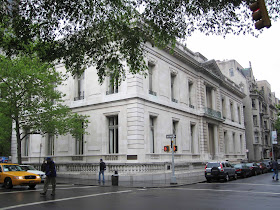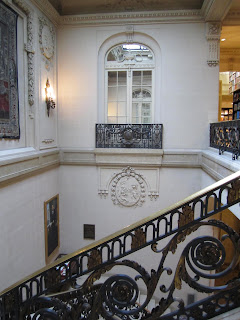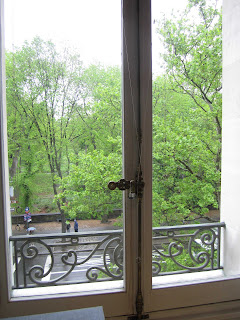
This is the James B. Duke house at 1 East 78th Street, designed by Philadelphia architect Horace Trumbauer and completed in 1912. Its combination of erudition, presence, craftsmanship, sophistication and formality - not to mention its honking big size - touches my aesthetic heartstrings. All my life I've wanted to explore this house, and that's exactly what I did, from basement to attic, last Wednesday.
Perhaps you've noticed on your own visits to big old houses, that there's often a line in the literature like, "After making a fortune in storage batteries, he built this copy of the Ca d'Oro in the Cleveland suburbs." Or, "Fond memories of youth in the German countryside led him to create a replica of Mad King Ludwig's Neuschwanstein Castle on the shores of the Long Island Sound." I don't know about you, but to my eye these "copies" and "replicas" often have about as much in common with the Chrysler Building as they do with their supposed models. Concerning 1 East 78th, distinguished opinion tells us it is based on the Chateau Labottiere in Bordeau, France, completed in 1773. For once, that would seem to be pretty close to the mark.

During the first quarter of the twentieth century Horace Trumbauer (1868-1938) turned out a magnificent opus of buildings fit for a beheaded French king. Besides the Duke house, the firm did Clarenden Court (wake up, Sunny) and the Elms in Newport (for coal baron Berwind and his sister), Shadow Lawn in West Long Branch, NJ (the five-and-dime president's palace, now part of Monmouth University), the Philadelphia Museum of Art (hello, Rocky), Lynnewood Hall (for Widener, the Philadelphia traction king), and hundreds of others, not forgetting the Philadelphia Racquet Club, where my excellent daughter was married last year.


According to Shakespeare, "All the world's a stage; And all the men and women merely players." Trumbauer, the creator of this particular stage, was an anomalous sort of fellow. Son of a salesman, he bootstrapped himself into the one percent of his day, in spite of debilitating shyness and a conviction that his work wasn't really top drawer, a judgment shared by many of his colleagues. Active in an era of appalling racism, he hired an African-American, Julian Abele (1881-1950), as his chief designer. Typical of big time architects, it's not clear how much of the firm's later design work was Trumbauer's own and how much was that of Abele.

North Carolina native James Buchanan Duke (1856-1925) - "Buck" to his pals - was your prototypical nineteenth century American tycoon - in this case in tobacco and electric energy. Reduced to beggary at the end of the Civil War, Washington Duke and his sons, Buck and Ben, salvaged the one thing the Yankees hadn't burned or taken, a barn full of tobacco leaves. They loaded them into a cart, hitched it to a half dead mule, and sold them in the nearest town. Such was the beginning of the American Tobacco Company, which by 1890 was supplying 40% of America's cigaret tobacco. In 1904, the Duke boys went into the hydro-power business, eventually establishing a grid that powered much of the Carolina Piedmont. Ironically, the planning and construction of 1 East 78th occurred at precisely the time Roosevelt-era trust busters were busting up American Tobacco.

In 1958, architect Robert Venturi altered the Duke house for a new tenant, New York University's Institute of Fine Arts. On the whole, he didn't do too much damage, although impractical me would have thrown myself bodily in the way of some of it. Save for the absence of original furniture and a modest overlay of institutional signs, folding chairs, study tables, etc., the interiors' original coup d'oeil (the work of the French decorateur L. Alavoine) is relatively intact. This is particularly the case in the main hall, a noble space if ever there was, containing what is surely one of the most magnificent townhouse stairways in Manhattan.






The first floor of the Duke house, like the eighteenth century itself, resonates with elegant simplicity. Salon, library, dining room, ballroom, plus two dressing rooms for arriving male and female guests, radiate from the main hall in cardinal directions. Here's the door to the ballroom.

White and gold ballrooms were "de rigeur" in houses like this, even apparently for guys named Buck. How nice it is to see gold trim in the hands of a designer who never blunders into gaudiness. The trick is knowing when to stop, which, God knows, is a lesson we all could learn.




Next to the ballroom, moving clockwise, is a salon overlooking 78th Street. These interiors really are something, aren't they? According to legend, Stanford White would burst into his office first thing in the morning, still in evening clothes from the night before, peer over his chief designer's shoulder saying "yes" to this and "no" to that, then stagger home to sleep it off. White, Trumbauer and others like them were responsible for client relations and overall schemes, but it was their designers who converted the boss's promises into plans and elevations.




On each side of the front door were dressing rooms (take off your coat, straighten your jewels, take a pee as the case may be) with powder rooms attached. These are offices now and only part of one of the bathroom survives.




Is there anyone who has walked past 78th and Fifth without peering into the windows of this room? The owners of houses like this, as often as not, didn't actually read very many books, but they all had grand libraries.




The dining room is a tour de force in contrasting shades of pale marble accented with gold. Once again, there's a lot of gold going on here, but absolutely not too much.






The door in the middle of the frame below goes to the serving pantry, an elephants' graveyard of subway tiles. A dumbwaiter to the downstairs kitchen was obliterated by installation of a new fire stair. Absent that, the pantry is in almost original condition.


Incidentally, the house outside the window was a gift to Payne Whitney from his Uncle Oliver Hazard Payne. Cranky Col. Payne's own house was the subject of "Big Old Houses" two weeks ago.




There is, of course, an elevator, happily untouched.


Family and guestrooms radiate off a grand second floor hallway whose dominant architectural feature is Trumbauer's knockout staircase.






The most glamorous player on this stage was Duke's only child, Doris (1912-1993). The "world's richest girl," as the press relentlessly called her, was only twelve when her father died. His famous last words to her, delivered on his deathbed (if we are to believe accepted wisdom) were, "trust no one." When his executors finished deducting sixty-seven million dollars to create The Duke Endowment, little Doris had about a hundred million 1925 dollars left for herself, a sum equal to something over a billion today.

Doris Duke was married and divorced twice, the first time to James Cromwell (below on the right), son of Eva Stotesbury of Whitemarsh Hall, another Trumbauer palace outside Philadelphia.

Her second husband was polo-playing, womanizing, sports car driving, Dominican playboy-diplomat Porfirio Rubirosa. It is a sad footnote to the lives of women like Doris Duke that she reportedly had to pay Rubi's second wife, French actress Danielle Darrieux, a million dollars not to contest his divorce.

Hard to see perhaps, but this is Doris Duke's bedroom. It was sufficiently high studded to permit installation of a two-level steel-supported library stack that just sits in the middle of it. The original architectural finishes appear to be intact


The entire second floor is devoted to library and study areas. Architectural finishes in the other bedrooms are more visible, despite random book-laden mezzanines.






A three-room master suite - his and her bedrooms on either side, a boudoir in the middle - appears to have stretched across the Fifth Avenue facade of the building. The corridor beyond the arch in the photo below gave access to all three rooms. The door in the middle leads to the boudoir.

Here's the southern master, probably Mrs. Duke's. Of course, maybe Buck and Nanaline slept in the same room. (You think?)




A terrific closet/dressing room is attached to this master, complete with safe and vintage mezzanine.







If I'm correcting reconstructing the Dukes' domestic arrangements, this room would have been a boudoir between the two bedrooms. I can't think what else it could have been since it never had an en suite bath.


The wall below is in what I'm pretty sure was the second master bedroom.

The original back stair is an unintended work of industrial art.


On the third floor are lots of doors leading to lots of maids' rooms, now used for staff offices.

I love old service areas. While the kitchen at 1 East 78th has been dismantled, just enough original finish survives on the basement level to give an evocative sense of its original appearance.


This was the laundry room, whose completely tiled walls and ceiling have, for some inexplicable reason, been painted.

Doris Duke and her mother gave 1 East 78th Street to NYU in 1952, after which Doris's privileged and eventful life was led on other stages. She was, among other things, a foreign correspondent, competition surfer, conservationist, historic preservationist, champion of Imelda Marcos, aficionada of jazz music and a believer in reincarnation. After a face lift at the age of seventy-nine, she refused to stay in bed, fell down and broke a hip - the classic death sentence for the elderly. Two surgeries followed, after which she died of a stroke.
Also not an actor on this particular stage was Julian Abele, seen below. There is uncertainty and just a little fear on that handsome face. Being black in racist turn-of-the-century America, he very probably felt both, even in Trumbauer's world of rich and cultured clients. Abele took credit for the design of only one building during his entire career, the Duke Chapel in Durham, NC. He never made the claim himself, but the the Wildenstein Gallery on East 64th Street is generally attributed to him as well. Trumbauer spotted Abele in 1902 when he was fresh out of the University of Pennsylvania's architectural school. Abele was not only it's first black graduate, but also the president of the university's Architectural Society. Trumbauer subsequently underwrote three years of study in Paris for Abele. In point of fact, Abele did a great deal of Trumbauer's heavy lifting. When the Depression hit and business collapsed, Trumbauer descended into alcoholism. After his death in 1938, it was Abele who kept the firm alive.

Abele also designed Irvine Auditorium on Penn's campus.
ReplyDeleteInformative and fascinating! Apparently, this house was built largely for Duke's wife who had a yen to crash NY high society. She succeeded well enough (Duke also bought her a former Vanderbilt estate in Newport which is now a museum) but Doris was less attached to this house and was happy to give it to NYU. Doris enjoyed spending time at her father's huge "farm" near Somerville, NJ, scheduled to open as a public park later this month. Trumbauer's firm designed a stately Louis XIII style mansion for that property as well but it was never built.
ReplyDeleteThis house turns up as a location shoot for the occasional movie or TV show. I recently spotted the exterior used as a Paris hotel on "Pan Am".
Thanks for the tour. I found your blog while doing research on the Vanderbilt home at 660 Fifth Avenue and I've just ordered your 1991 book on the Gilded Age mansions and their architecture. Can't wait to get it. Thanks for a great site. I look forward to reading all your back posts.
ReplyDeleteI teach American history and am quite impressed with your photo essay on the house. I have been looking for 30 years for these images! All too often Gilded Age mansion interior on-line images are evasive. My students were amazed; this site a great way to reach them. Now on to the new quest: Period photos of the house. Thank you so much.
ReplyDeleteWhat I had visitors in New York I always brought them by this beautiful house. Sometimes the door was open so we could walk into the foyer and see the grand staircase. How wonderful that it is still being taken care of. Thank you for all you do
ReplyDeleteThank you very much for this fantastic tour!
ReplyDeleteWonderfully detailed post about a fascinating mansion on the UES. Recently discovered that they filmed the big engagement party scene for the 1981 comedy "Arthur" inside the main foyer.
ReplyDelete